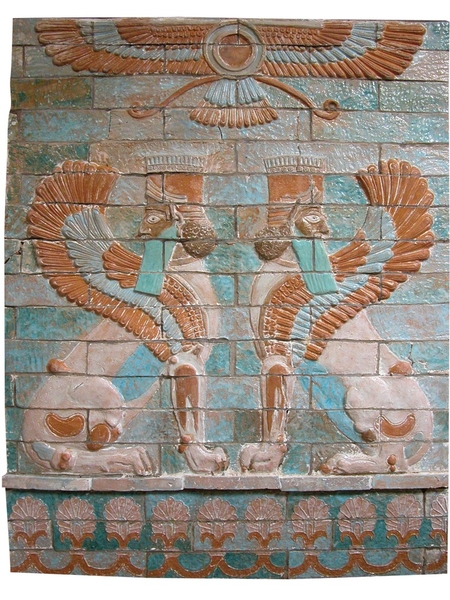Description
Relief of Ahura Mazda. Decorative mural made of fired clay with polychrome ceramic finish, inspired by ancient art. We present a mural of modeled and glazed bricks as they were worked in antiquity.
This product, if desired, can be requested mounted on an iron structure to avoid embedding in the wall. Request a quote.
Measurements: Height: 124 cm. Width: 100 cm. Depth: 5 cm.
Reproduction of a relief of Ahura Mazda with the Persian sun emblem, inspired by a glazed ceramic relief (approx. 6th century BC) found in Susa, present-day Iran. It depicts the winged sun disk atop two sphinxes standing guard.
Ahura Mazda is the supreme god of Zoroastrianism, the religion of the Persian Empire, opposed to the divinity of evil, Angra Mainyu or Ahriman. Creator god of light, fire, and sky, with the reform of Zoroaster he became a more transcendent and abstract concept, almost without anthropomorphic representation. The symbol of Ahura Mazda, the winged sun disk, recalls other images such as the Ra disk in Egypt. Zoroastrianism remains an active religion today.
The Persian Empire was founded by King Cyrus the Great in the 6th century BC, becoming one of the most influential civilizations of antiquity. Its vast territory extended from the Mediterranean to the Indus, encompassing unprecedented ethnic and cultural diversity. The Achaemenids implemented a centralized government and efficient administration that favored the management of a vast empire. A communication system was established through the famous Royal Road, which traversed the empire’s territories from west to east from the coast of Turkey to Persepolis, facilitating trade and information transmission. The Persian Empire was known for its religious and political tolerance, allowing conquered peoples to retain their traditions and religious practices. The conquest of Alexander the Great in the 4th century BC marked the end of the Achaemenid dynasty, giving way to the Hellenistic rule of the Seleucid empire, until the conquest of the Parthian king Arsaces in the 3rd century BC.












Reviews
There are no reviews yet.